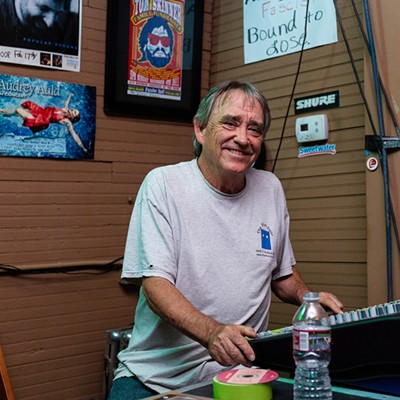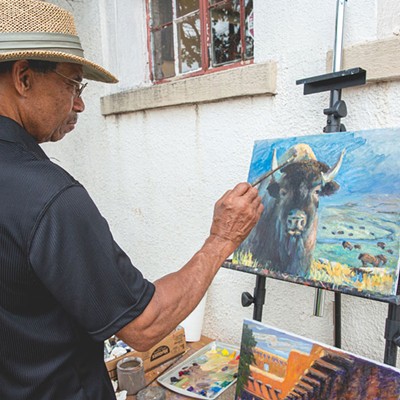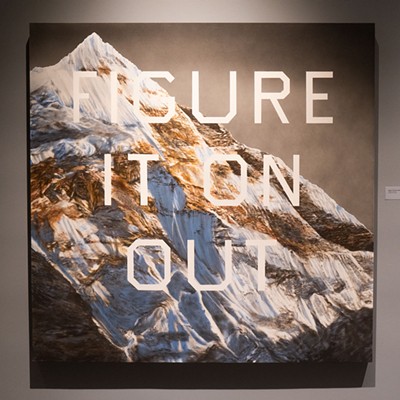
Nestled between N.W. 28th Street and N. Walker Avenue, to N.W. 30th Street and N. Dewey Avenue and encompassing an elegant, curving street and fanciful Spanish Revival architecture, The Spanish Village shopping center made its debut in 1929 on the cusp of the Great Depression.
In those early days, Nichols couldn’t have imagined that 83 years later, the area known simply as “Paseo” would have morphed quite so dramatically. From shopping center, to a decaying inner-city neighborhood that seemed destined for the scrap heap of urban ignominy, to Oklahoma City’s oldest artist community, the little district that could is now one of the state’s most distinctive destinations.
But Paseo’s surprising evolution doesn’t stand solely on its artistic merits. Named one of America’s 10 great neighborhoods by the American Planning Association in 2010, and garnering national attention from the likes of Forbes and Travel & Leisure, Paseo is celebrated as a comeback kid in revitalization and redevelopment circles.
Perhaps even more striking, in one of the most unlikely places in the world — the heart of conservative, conventional Oklahoma City — this charming, enigmatic town-within-a-metropolis is known throughout the state as one the best places, if not the best place, for a heady dose of Bohemia.
Reincarnation and renaissance
Paseo’s reincarnation and renaissance didn’t happen overnight, of course, and its history and the story of its recovery make a compelling saga, rendered with palpable pleasure by John Belt, local attorney and historic-property developer widely credited with being pivotal in this Cinderella-tale-come-true. From the beginning, Belt’s motive for redeveloping Paseo was rooted in his lifelong love of the arts and the creative process.
“The fun I take away from all this is the creative aspect of it. I look at things and study them until I know what I want them to be,” said Belt. “We didn’t have an arts district and I’ve been involved in the arts all my life. We really needed a place for the artists to have a home ... where they could work together.”
Belt kicked off Paseo’s recovery in 1976 when Hiram’s, a local sandwich shop on Paseo Street (located where Picasso Cafe is today), was threatened with closure by a local
property owner who wanted the site for more warehouse space. With fond
childhood memories of the area and as a patron of Hiram’s, Belt didn’t
want to see the neighborhood slip into further desolation, so he
purchased that site — and, eventually, virtually all of the properties
on Paseo.
And the rest, as the cliché goes, is history.
Yet
Belt notes Paseo’s reincarnation is hardly the tale of one man’s
triumph over urban decay. Rather, it is a journey of many: visionary
volunteers, artists and leaders, nonprofits and granting foundations,
and a mostly supportive municipality. It is an ongoing process filled
with determination and hard work, and perhaps most important, it is a
remarkable example of what can be accomplished when ordinary people
commit to collaborating on behalf of a community.

Plunging into the future
On Friday, the 36th annual
Paseo Arts Festival kicks off, and festival-goers familiar with the area
are bound to notice the striking transformation of the white,
boarded-up eyesore that once inhabited 3010 Paseo, into an inviting
architectural treasure in warm hues with a dash of Mediterranean allure.
The 28,000-square-foot
building that once housed a swimming pool and make-your-own pizza place —
and was formerly known in various incarnations as the Paseo Plunge, The
Jamboree Surf Club and The Spaghetti Factory, among others — is another
signature Belt project. He anticipates a small coffee and sandwich shop
will open on the first floor within the next six months, with the rest
of the building’s interior spaces to be completed later.
Although
Belt said he’s still exploring possibilities for the rest of the space,
he envisions artists and the arts as being an integral part of the
building’s future. He and Jo Wise, Paseo Arts Association executive
director, noted the distinct probability of office and gallery space for
the association, studios for artists, and meeting and event space.
“Paseo
is hot right now. We want to collaborate with others, and combining
efforts is a way to grow the arts community in Oklahoma City,” said
Wise.
One might be
tempted to think the renovation of the Plunge could be Belt’s capstone,
but he laid that notion soundly to rest: “Nothing sounds worse to me
than the boredom of not doing. There’s always something to be done.”
Just
down the block and around the corner at 612 N.W. 29th, James Varnum and
Amy Young are evidence the next generation is continuing the momentum
of Paseo. Business partners and friends, Young and Varnum are renovating a
2,800-square-foot building built in 1929, now called “SixTwelve.” The
duo’s goal is to transform the former eight-plex into a community center
that can be used by multiple organizations for projects, education,
sustainability and creativity.
“We
want to offer a place that encourages people to live a pedestrian,
sustainable lifestyle, to be an answer in our city to urban sprawl. The
public health issues connected to this are so important,” said Young.
Varnum
and Young are incorporating a variety of eco-friendly features,
including energy-efficient windows that meet historic preservation
standards, and reusing bricks from the original building. Along with a
few residential units for visiting artists and educators, the building
will feature classrooms, a kitchen and a community space that opens onto
an organic garden. They hope SixTwelve will be ready to open within the
next year.
“We want
to create a space that’s inviting and vibrant,” said Varnum, “where you
can experience the gamut of art, DIY projects, tap into the local food
system, and move from gardening to preparing local food — all in a
community atmosphere.”

The je ne sais quoi of Paseo
“Paseo” means “walk” in
Spanish, and in an era when walking and trolleys were still a popular
mode of getting around and not everyone had cars, the Paseo was built
for walking. Today that walkable flavor, part of the area’s inscrutable
charm, or what some call “Paseo magic,” is also part of its enduring
strength.
Ask any Paseo patron or
artist what he or she loves about Paseo and you’ll likely hear a
romantic take on visiting an artist’s studio and being blown away by
watching the artist work, or on the joys of First Friday Gallery Walk,
where studio and gallery doors are thrown open, welcoming friend and
stranger alike to savor the artistry found at more than 60 artist spaces and 17 galleries.
Probe
a little deeper into the Paseo magic and patrons and artists grow
wistful. It is as though you’ve accidentally brushed up against a
special secret, a thing that touches them deeply.
Physician’s
assistant Tony Sharp resides in the Jefferson Park neighborhood
adjacent to Paseo. Sharp and his wife, Clarissa, an artist, have a long
and fond association with Paseo.
“The
fluidity of the place may be part of its endurance,” said Clarissa
Sharp. “Some changes are good, some are sad, but knowing that change is
inevitable means it’s a living, breathing place, and if circumstances
aren’t right today, they may be better next month or next year.”
Tony
Sharp sees Paseo as multidimensional, layered and unpredictable; he
said the area elicits a response comparable to “wonderment seen in
children, even if only when seeing the brightly colored buildings for
the first time. It is different. Nothing else in Oklahoma City or even
the state is quite like it.”
M.J.
Alexander, award-winning photographer and author, has a studio on
Paseo, and remembers doing a double take when she discovered Paseo after
moving to Oklahoma City from Vermont in 1998.

“In
a pretty much flat, wide-open, sprawling city laid out on a grid, you
have this little stretch of low stucco shops and studios nestled around a
curving street with a downhill slope. It’s a little Mediterranean, a
little bit Epcot — and a lot of fun,” said Alexander.
“The
light is different here. It’s the colors and textures of the buildings,
the intimate scale of the neighborhood, the swoop of the street that
makes it impossible to see the end
from the beginning. … At the right time of day and in the right frame of
mind, the Paseo is the closest thing we have to a practically-perfect-in-every-way Truman Show cinematic backdrop.
“But
beneath the surface, there’s a grittier authenticity and a
weather-beaten patina of survival. That’s the part that speaks to me.”
Hey! Read This:








